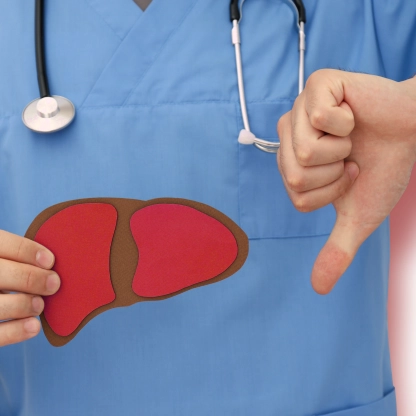
Article summary
Topic
Hepatic cirrhosis is a chronic condition that results from long-term injury of the liver. Cirrhosis develops as a result of fibrosis – a process in which liver cells (hepatocytes) are replaced by connective tissue fibres, which ultimately leads to their death and interferes with normal function of the liver.1 Scars and nodules appear instead of smooth tissue, and the liver becomes harder. When cirrhosis develops, the liver is no longer able to perform its tasks such as breaking down harmful substances and cannot produce the sufficient amount of proteins and other compounds that are necessary for blood clotting.
Cirrhosis is a chronis condition resulting from long-term damage to the liver
What leads to cirrhosis?
- alcohol abuse,
- NAFLD (non-alcoholic fatty liver disease) and NASH (non-alcoholic steatohepatitis),
- long-term viral hepatitis (of type B or C),
- autoimmune hepatitis,
- chronic biliary tract disorders,
- certain toxins and medicines,
- complication of metabolic disorders (such as obesity, diabetes, metabolic syndrome).1
How is cirrhosis diagnosed?
Up to 30-40% of persons with hepatic cirrhosis learns about this disorder only during routine tests or tests related to other diseases.2 This is due to the fact that cirrhosis does not give any characteristic symptoms at an early stage.
Symptoms at an early stage of the disease:
Malaise and constant fatigue
Loss of appetite and weight loss
Attention deficit
Nausea and vomiting
Trouble sleeping
Symptoms at a more advanced stage of the disease:
- itching of the skin,
- yellowing of the eye whites and the skin (jaundice),
- swelling in the legs and feet,
- abdominal swelling,
- dyspnoea,
- fever,
- dizziness,
- vomiting blood,
- dark or black tarry stools,
- mental confusion.2
Accelerate liver regeneration with Phospholipids (Essentiale® Forte P)
How is hepatic cirrhosis diagnosed?
It is not easy to diagnose hepatic cirrhosis. After a thorough interview, the doctor refers the patient to a number of tests that are to confirm or rule out the suspicion of cirrhosis.
Diagnostic tests for this disease include:
- laboratory tests (blood count and levels of blood glucose, hepatic enzymes, hepatocellular carcinoma marker AFP, bilirubin),
- imaging examinations (abdominal ultrasound scan),
- endoscopy (gastroscopy),
- histopathological examinations (liver biopsy),
- examinations with the use of elastography (a method similar to ultrasound, which visualises the advancement of hepatic fibrosis).
How is hepatic cirrhosis treated?
The method of cirrhosis treatment always depends on the cause and stage of the disease.
Cirrhosis caused by infections with hepatitis viruses (e.g. HBV or HCV) is treated with medicines that are to eliminate the virus from the body.
On the other hand, in alcoholic cirrhosis it is necessary to makes some lifestyle changes – complete abstinence and embarking on an addiction therapy programme. It is absolutely essential to abstain from alcohol, which slows down disease progression in each form of cirrhosis.
How to prevent hepatic cirrhosis?
Some causative factors of cirrhosis can be classified as external – they are related to the lifestyle or treatment that causes irreversible damage to the liver. They are factors that can be influenced and eliminated. An equally important element of prophylaxis is a safe lifestyle that allows for minimising the risk of infection with hepatitis C virus and vaccination against viral hepatitis B.3
FAQ
Hepatic cirrhosis develops very slowly. There are 3 clinical stages of fibrosis. Each of them may persist for a long time, but the more advanced the fibrosis, the more rapid the progression to cirrhosis. Organ cirrhosis with life-threatening complications occurs at the most advanced stage.3
Since hepatic cirrhosis is a chronic disease that cannot be reversed, continuous treatment is necessary. At best the therapy may lead to compensated hepatic cirrhosis. Nevertheless, the cirrhosis patients should regularly visit a specialist to assess their hepatic function and prevent complications from recurring.3
- https://www.nhs.uk/conditions/cirrhosis/
- https://www.medicover.pl/o-zdrowiu/marskosc-watroby-przyczyny-objawy-i-leczenie,100,n,192
- Marskość wątroby, dr hab. n. med. M. Wawrzynowicz-Syczewska, Katerda i Klinika Chorób Zakaźnych i Hepatologii, Pomorski Uniwersytet Medyczny w Szczecinie, accessed on: 9/02/2021: https://www.mp.pl/pacjent/gastrologia/choroby/watroba/50969,marskosc-watroby
%20(1)%20(1).webp)

